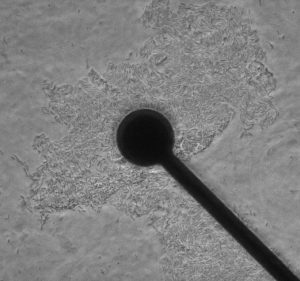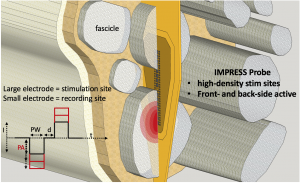Current Projects
Design Support for Novel Electrode Interfaces in Peripheral Nerve Prostheses
Erin Patrick, Jack Judy
To better serve the demands of the amputee population, there is a need to increase the number of independent channels of motor-control and sensory-feedback information used with prosthetic limbs. As a result, there is a drive to increase the number of channels in intraneural peripheral-nerve interfaces. Today, neural interfaces to peripheral nerves are not rationally designed. Instead designs are strongly guided by historical precedent and the limitations associated with the manufacturing processes and/or implantation methods used. The primary goal of this work is to develop designs for prototype interfaces that maximize information exchange with major peripheral nerves in the human upper extremity.
Simulation of Josephson Junction Process and Device Performance
This collaboration is part of a large team directed by researchers from USC and Stellenbosch University (ColdFlux).
UF PI: Mark Law, Collaborator: Erin Patrick
Funding: IARPA, Supertools Program
Currently the contract is centered on accurately simulating the process steps involved in the manufacturing of digital superconducting devices in 2D. These process steps consist of oxide deposition, sputtering, metal oxidation, and anodization. Our group seeks to develop an understanding of the key parameters in superconducting device design. Efforts toward this goal include the aforementioned process modeling as well as device modeling. Device modeling consists of both microscopic and mesoscopic methods for proper simulation of device operation. The microscopic model we are investigating is the tight-binding Bogoliubov-de Gennes (BdG) Hamiltonian. We are also exploring magnetic effects as well as long junction effects using the phenomenological sine-Gordon equation.
Completed Projects
Probing the Electrical Nature of Biofilm Growth
PI: Erin Patrick, Co-PI: Steve Hagen (Physics)
Funding: UF Opportunity Seed Fund 2018
The bacteria that form a biofilm coordinate their behavior through signaling mechanisms that promote the growth of the biofilm as well as its resistance to physical and chemical methods of removal. Consequently, understanding how bacteria coordinate their behavior is key to developing novel methods for controlling biofilms and mitigating the problems that they cause in many health, industrial and environmental systems. Recent data has suggested that electrical communication may play an important role in biofilm growth by acting as a long-range signal of the metabolic state of cells. However, the fundamental relationship between electrical signals and biofilm growth is not understood.
This research project is a new collaboration that aims to design a novel, electrical approach to controlling biofilm growth. The project will combine experimentation with computational modeling in order to understand how electrical signaling influences biofilm growth and then develop and test methods for controlling biofilm growth by electrical rather than chemical means.

Electrical Simulation of Adipose-derived Stem Cells for Secretome Therapeutic
PI: Christine Schmidt (BME), Co-PI: Kieth March (COM), Collaborator: Erin Patrick
Funding: NIH (R21)
This project aims to develop a therapeutic treatment for spinal cord injuries that will aid the body in repairing damage via an injectable scaffold derived from decellularized nerve tissue in combination with novel secretome from electrically stimulated adipose derived stromal/stem cells (ASCs). This novel therapeutic system will benefit from both electrical stimulation and stem cell therapy while eliminating limitations and complications associated with those techniques. As such, the proposed work is the first step in a continuum of research and development efforts that could eventually translate to better recovery outcomes for individuals suffering from spinal cord injuries.
GaO Radiation and Edge Termination Effects
PI: Steve Pearton (MSE)
Funding: DTRA
Objective: To understand the low and high dose stability of β-phase of Gallium Oxide to neutrons, electrons and protons, in order to simulate common radiation environments. Measure fundamental parameters such as carrier removal rate, energy level and thermal stability of traps and role of hydrogen.
Method: Unique coupling of theory and experiment to produce a detailed understanding of the effects of radiation on this promising wide bandgap semiconductor and a predictive capability for new radiation hardened materials and components.
GaN-based HEMT Radiation Effects
PI: Steve Pearton (MSE)
Funding: DTRA
The goal of this project is to assess radiation effects on the semiconductor Gallium Oxide. Our role is to model various degradation mechanisms caused by radiation and simulate of their effects on device performance.
IMPRESS:Implantable Multimodal Peripheral Recording and Stimulation System
PI: Rizwan Bashirullah (ECE)
IMPRESS aims at developing a chronic interface system that allows robust, intuitive, natural, highly functional control of multiple degrees of freedoms, by decoding the activity of motor neurons from ENG recordings and stimulating populations of afferent fibers. The main characteristic of the approach is the development and application of high-density, transversal intrafascicular nerve electrodes (IMPRESS) that allow the spatial sampling (in both recording and stimulation) over several sites (hundreds) within the same nerve.
